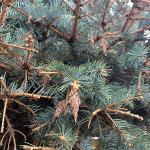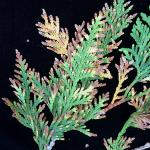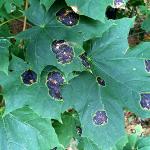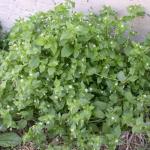UMass Extension's Landscape Message is an educational newsletter intended to inform and guide Green Industry professionals in the management of our collective landscape. Scouts compile and record environmental and phenological data for locations throughout Massachusetts to aid in the monitoring of plant and pest development, the planning of management strategies, and the creation of site-specific records for future reference. Detailed reports from Extension specialists on growing conditions, pest activity, and cultural practices for the management of woody ornamentals, trees, and turf are regular features. UMass Extension has updated the following issue to provide timely management information and the latest regional news and environmental data.
The Landscape Message will be updated monthly for the remainder of 2014. The next message will be available on December 5. To receive immediate notification when the next Landscape Message update is posted, be sure to join our e-mail list.
Scouting Information by Region
Regional Notes
Cape Cod Region (Barnstable):
General Conditions: October saw a total shift in the weather pattern that had predominated on the Cape since last May. The month opened with some much needed rainfall, approximately 2.5" in the Marstons Mills area, and the rain continued to arrive on a frequent basis, giving a whopping total of 10.8" recorded in the rain gauge in the Mills. Differing amounts fell in different areas of the Cape but overall it was a wet month! The temperatures fluctuated by the week, with the month opening on a cool note only to jump up to the 70s F by mid-month, dropping back into the 50s F the next week, and ending the month in the upper 60s. No frost, light or heavy, occurred in October. November opened with a classic northeaster, bringing high winds and heavy rain that ended with a dusting of slushy snow. Winds in excess of 60mph were recorded in many towns on the Cape, bringing down both entire trees as well as many branches. Overnight temperatures on November 2/3 went as low as 32° F and some areas had a light frost for the first time this season. Lawns are still green and growing and roses are still blooming. Pests/Problems: Adult deer ticks are active and thorough tick checks should be done after doing fall clean ups. There was some tree damage due to the high winds of the northeaster on November 1 and 2 and there is a need for pruning of broken limbs. Continue to mow actively growing lawns until the end of the mowing season.
Southeast Region (Hanson)
General Conditions: Hanson received 9.65 inches of rain and approximately one inch of snow. The rain was welcome as previous to this past month, soils were extremely dry and plants were stressed. Similar to last year, October was warm, actually one of the warmest on record, with many days in the mid-60's to low-mid 70's. There has been no killing frost or deep freeze to date and until the nor'easter came in on November 1-2, Coleus still looked colorful! The Nor'easter brought high winds (with gusts in some locations of 63 mph), rain, sleet and approximately one inch of snow. The Boston Globe reported that the storm "deposited the most snow recorded on any November 2nd in 120 years". Temperatures dropped on the early morning of Nov. 2nd, but not low enough to kill annuals and tropicals like lantana, geranium, marigolds, Canna and New Guinea impatiens. The high winds blew many leaves off trees but fall foliage color remains with many plants like: birch, oaks, Enkianthus, Styrax obassia, Styrax japonica, Clethra, Hydrangea quercifolia, Hydrangea petiolaris 'Anomala', Cornus sp.Asian maples, (Japanese, Paperbark, etc), Calycanthus sp., witchhazels, redbud, Chionanthus virginicus, Viburnums, Fothergilla sp., etc. Landscape roses like Rosa rugosa 'Linda Campbell' and Rosa 'Martha's Vineyard', along with Sedum 'Autumn Joy', Nippon daisy, Corydalis lutea, Lamium, annual Rudbeckia and Aconitum sp. (Monkshood) continue to provide a smattering of late flowers. Fall cleanups have started and should continue as many trees have yet to drop their leaves. Lawns are green and growing and will need to be mowed until they go dormant. Pests/Problems: Not much to report in the way of insect and disease problems. Boxelder beetles are still active along with ticks, slugs and snails. Deer ticks remain plentiful and reports have come in of people finding deer ticks on themselves and their pets. Continue to take precautions against deer ticks especially during fall cleanups and remember that deer ticks may be active any time the temperature is above freezing. Continue to monitor for Hemlock Wooly Adelgid. The fall invaders (Asian ladybugs (Harmonia axyridis) and Western Conifer Seedbugs) have started to enter buildings, looking for a warm spot to overwinter. Deer are actively browsing landscape plants and voles and field mice remain active. Now is a good time to remove vegetation from around landscape plants and to cleanout perennial beds and borders to reduce habitat for overwintering mice and voles.
North Shore Region (Beverly)
No written report available this month, see Environmental Data below.
East Region (Boston)
General Conditions: We finally received much needed precipitation in the month of October. We received two large rain events, the first during the 1st and 2nd of the month, dropping 1.31 inches and the second, a nor'easter, arriving on the 22nd, 23rd, and 24th, amounting to 3.2 inches of rain. The total for the month of October was 5.51 inches more than double the month of August and September combined! November began with a nor'easter on the 1st and the 2nd, bringing an additional 0.74 inches of precipitation equivalence including a few hours of snow flurries on the 2nd. The coldest temperature since April 21st was on October 20th when temperatures dipped to 33o F. We have yet to receive a killing frost this fall. For the month of October, low temperatures ranged from 33o F to 62o F, averaging 47o F; high temperatures ranged from 50o F to 81o F, averaging 64o F. October 14th through 16th saw a warm front move through, we received a high of 81o F on the 15th, accumulating 21.5 GDDs on that day. Montauk daisies have been in bloom for the past three weeks, many plants continue to display fall color including, Acer (maple), Fagus americana (American beech), Oxydendrum arboretum (sourwood), Parrotia persica (Persian ironwood) and Stewartia (stewartia). Several Japanese maples (Acer sp.) and the Korean maple (Acer pseudosieboldianum) are providing brilliant colors of red, orange and yellow to the landscape. Several Ilex sp. (holly) are in full fruit. Snapping turtles have been observed making their annual trek to the meadow for the winter. Pests/Problems: The first nor'easter of the season arrived on October 22nd, delivering 3.2 inches over three days. Wind gusts peaked at 41.2 mph overnight on the 22nd and into the upper 30's early in the morning on the 23rd. We experienced mostly minor damage with smaller limbs down. We received a microburst near the Center Street gate area of the Arboretum, which resulted in two complete losses. An old hickory (Carya) along with a centenarian pin oak (Quercus palustris) were completely uprooted and broken below the base. Bare spots in turfgrass are revealing the existence of crabgrass and other turf weeds now gone to seed. Black swallowwort (Cynanchum nigrum) seedpods continue to open and spread seed into the landscape. Perennial vines Oriental bittersweet (Celastrus orbiculatus) and porcelain berry (Ampelopsis brevipedunculata) can be easily spotted at this time of year as their respective fruits, bright orange and speckled turquoise berries stand out in the landscape.
Metro West (Acton)
General Conditions: 4.6" of much needed rain was recorded in the Acton area for the month of October, exceeding the monthly average of 4.32". Also recorded were 98.5 growing degree days for the month. Overall, I would say that October was a good month for this area, although we did not experience the microbursts, extreme flooding and strong winds as other areas did. Still in bloom are some late flowering perennials including Aster tataricus 'Jindai' (Tatarian Aster) and Nipponanthemum nipponicum (Montauk Daisy). Pests/Problems: Nothing to report.
Pioneer Valley Region (Amherst)
General Conditions: The autumn season continues in the Pioneer Valley with the passing of peak foliage and the end of daylight savings time. The brilliant fall color provided by maple, ash, hickory and birch has mostly come and gone. Golden-colored oaks are still holding their leaves and will do so for some time, due to incomplete leaf abscission that's characteristic of Fagaceae. After a dry and unseasonably warm September, the month of October brought welcome rainfall starting on the very first day of the month. With over five (and even six) inches of precipitation recorded at many weather stations in Franklin, Hampshire and Hampden Counties, trees and shrubs received a thorough soaking during a time when many are allocating resources to root development. There were three rain events (10/4, 10/16 and 10/22-23) where over one inch of precipitation was recorded. The last of these storms (which was very similar to a spring nor'easter) deposited over 2.5" of rain in many locations. At Barnes airport in Westfield, measurable precipitation was recorded on 13/31 days in October. Contrast that with only 4/30 days in September. The foothills of the valley experienced their first frost on 10/13 while low-lying areas didn't experience the 32° F threshold until 10/19 or 10/20. Overall, temperatures were seasonable in October, with highs in the 50s and 60s for much of the month. By far, the most noteworthy event during this reporting period was the microburst that blasted a heavily forested section of Mount Tom in Easthampton. Just before 5 AM on 10/8, a violent thunderstorm swept through Hampshire and Hampden Counties. A large swath of mature trees (oak, hemlock, hickory, birch and maple) on the steep, western slopes of the mountain were either uprooted or broken off on the main stem. Relatively few trees survived across the area of damage. Wind speeds were estimated at over 100 mph. According to the National Weather Service, "a microburst is a downdraft (sinking air) in a thunderstorm that is less than 2.5 miles in scale. Although microbursts are not as widely recognized as tornadoes, they can cause comparable, and in some cases, worse damage than some tornadoes produce. In fact, wind speeds as high as 150 mph are possible in extreme microburst cases." Aerial footage of the damage can be observed here: https://www.youtube.com/watch?v=JQhHNpZksHc Pests/Problems: There are no major pest or pathogen issues to report during this time of year. Autumn is a great time to reduce overwintering populations of foliar pathogens by cleaning up downed leaves and needles. If left on the ground under infected trees, these fungi can produces spores in the spring that will be blown up to newly developing leaves to initiate new infections. Even for conifers like eastern white pine, cleaning up fallen needles can help to reduce populations of opportunistic needle cast fungi like Lophodermium. If conditions have been dry, provide supplemental water to newly planted trees and shrubs.
Berkshire Region (Great Barrington)
General Conditions: After a very mild but wet October, temperatures have dropped to near seasonal averages. The mild conditions resulted in one of the more beautiful and prolonged fall foliage seasons in years. However, very strong winds of late have denuded most deciduous trees. Those species still with foliage are largely those which do not develop an abscission layer in their leaf petioles in fall. Examples of trees which retain their leaves through winter include most oaks (Quercus), American beech (Fagus grandifolia), witch hazel (Hamamelis virginiana), musclewood (Carpinus caroliniana), and ironwood (Ostrya virginiana). Though there have been a number of frost events during the past month, the coldest temperature recorded at the Great Barrington monitoring station was 29° F. Some snow fell over the first weekend of November but this was at the highest elevations in the Berkshires, e.g. Mount Greylock. Pests/Problems: After commenting about the low numbers of deer ticks observed in September, there has been a dramatic increase in deer ticks in the past month. Deer ticks are frequently found in lead litter. As such, precautions should be taken when raking and gathering leaves. Vole activity is also very high at this time. The same goes for squirrels and chipmunks. Deer browsing in managed landscapes is also increasing.
Environmental Data
The following growing-degree-day (GDD) and precipitation data was collected for an approximately 5 week period, October 2 through November 5. Soil temperature and phenological indicators were observed on or about November 5. Total accumulated GDDs represent the heating units above a 50° F baseline temperature collected via our instruments for the 2014 calendar year. This information is intended for use as a guide for monitoring the developmental stages of pests in your location and planning management strategies accordingly.
|
Region/Location |
GDD |
GDD |
Soil Temp |
Precipitation |
|
Cape Cod |
291 |
2647 |
62 |
10.80 |
|
Southeast (Wareham) |
243 |
2578 |
41 |
7.25 |
|
Southeast (Hanson) |
134 |
2605 |
48 |
9.65 |
|
East |
179.5 |
2797 |
53 |
6.25 |
|
Metro West |
94.5 |
2280.5 |
n/a |
4.60 |
|
Central (Boylston) |
n/a | n/a | n/a | n/a |
|
Pioneer Valley |
143 |
2741 |
52 |
5.58 |
|
Berkshires |
104 |
2139 |
48 |
5.45 |
|
AVERAGE |
170 |
2541 |
51 |
7.08 |
|
n/a = information not available |
||||
Woody Ornamentals
Diseases
Recent pathogens and insect pests of interest seen in the UMass Extension Plant Diagnostic Laboratory:
Elongate hemlock scale (Fiorinia externa) and spruce spider mite (Oligonychus ununguis) infestation on Fraser fir (Abies fraseri). Tree is approximately 15-years-old and has been present at the site for four years. Lower canopy branches displayed yellowing needles and premature needle shedding. Managing arborist noted the tree was planted too deep. Elongate hemlock scale is now a major pest of landscape fir and the cool summer conditions allowed the spruce spider mite to stay active for a longer period of time this season.
Tupelo leafminer (Antispila nysaefoliella) infestation on a black tupelo (Nyssa sylvatica). Mature tree, approximately 30" in diameter present at the site for decades. Late in the summer, tan-colored lesions were observed on the foliage. Upon closer inspection, the damage was clearly the result of leafminer. Pupating larvae cut a small hole in the mined portion of the leaf and then attach the resulting disks from the upper and lower leaf surface to their bodies before falling to the ground.
Cherry leaf spot, caused by Blumeriella jaapi, on Kwanzan cherry (Prunus serrulata 'Kwanzan'). 35-year-old tree present at the site for 15 years. Symptoms included numerous, brown-colored spots on the foliage. Many of these small spots had dried and fallen through the leaf, giving it the "shot hole" appearance. The spots were so numerous that many coalesced to create large, necrotic patches. This fungal pathogen is very common on cherry wherever they are grown.
Needle blight, caused by Phyllosticta and Rhizosphaera (secondary), on corkbark fir (Abies lasiocarpa var. arizonica). Corkbark fir occurs naturally at high elevations (>8,000 ft.) in the southern Rocky Mountains in Colorado, New Mexico and Arizona. Numerous trees, between 10 and 15-years-old, were planted over the past four years. Supplemental water has been provided during dry periods. Several have died outright while the remainders have browning needles and branch dieback. There are several species of Phyllosticta that cause needle blight of conifers, mostly in Christmas tree plantations.
Shoot and leaf blight, caused by Botryosphaeria, on blue holly (Ilex × meserveae). Shrub is estimated to be less than six years old and it's duration at the site was unknown. Several blue hollies growing in exposed, city conditions with deep shade and dry soils. Only one shrub was symptomatic and the fungal infection was severe. Abiotic stress often predisposes trees and shrubs to infection by Botryosphaeria.
Needle blight, caused by Phyllosticta thujae and spruce spider mite infestation (Oligonychus ununguis) on dark American arborvitae (Thuja occidentalis 'Nigra'). Numerous mature shrubs, 12-14' tall, planted one year ago as a property screen. Over the growing season, symptoms of decline (needle yellowing, premature needle shedding and shoot tip blight) developed and worsened as autumn approached. The dieback, coupled with typical autumn senescence, left the hedge "looking horrible". Establishment stress and winter injury almost certainly played a role, likely facilitating the fungal infection.
Report by Nick Brazee, Plant Pathologist, UMass Extension Plant Diagnostic Lab, UMass, Amherst.
Photos of recent samples submitted to the UMass Extension Plant Diagnostic Laboratory:
Weeds
Be sure to check out UMass Extension's Online Weed Herbarium!
Name that weed! (Click photo to enlarge, and click here for answer)
Landscape Turf
Management Practices
Winter on the Way
Now that Halloween has passed and our clocks have fallen back, the idea of the impending winter season becomes more of a reality with each passing day. Although the summer period often ranks at the top in terms of turf-related challenges in these parts, a primary limiting factor that dictates turfgrass adaptation is low temperature. Most perennial warm-season (C4) grasses are easily killed by lower temperatures, and are therefore much better utilized in warmer locations. Cool-season (C3) grasses are well-suited for culture in the Northeast because they have an inherent ability to survive the winter conditions typical of this region.
There are two basic mechanisms of turfgrass injury by low temperature, or what is often called direct low temperature kill:
Intracellular freezing occurs when the temperature dips to the point at which ice crystals form in the fluid within plant cells. The sharp crystals rupture the cell membrane resulting in leakage and eventual death of the cell. When this phenomenon occurs within the turfgrass crown (the main growing point of the plant) death of the entire plant is likely.
Extracellular freezing involves ice crystal formation outside of plant cells during low temperature exposure. The ice crystals create a negative potential gradient that draws water out of cells and leads to desiccation, cell collapse and death of tissue.
In response to shorter days and cooler temperatures in the fall, grass plants gradually shift resources away from growth and towards preparation for winter survival. During this acclimation to decreasing temperature (hardening), the ability of plants to reduce crown hydration and accumulate solutes such as carbohydrates, soluble proteins and amino acids helps to protect plants from direct low temperature kill. The period after which shoot growth ceases but the turf remains green is especially critical for acclimation. The bulk of the carbohydrates produced by photosynthesis during this phase are used by each plant to protect vital cells from freezing. A gradual decline in temperature over a period of 3 or 4 weeks is preferable during the last stage of the hardening process. Although air temperatures often fluctuate (sometimes considerably, as they have this season) soil temperatures are buffered and therefore the descent is typically more measured.
Even among well adapted cool-season grasses, there is significant variability in low temperature tolerance and overall winter hardiness at both the species and especially the cultivar level. Genetics, furthermore, are only part of the equation, as a whole series of environmental, management and plant factors will play a role in the actual risk of cold injury any given year. In the end, much depends on the quality of acclimation and also the timing and pace of de-acclimation come spring. A lot of frustration originates from the fact that many aspects of the process are beyond our control. Research is ongoing to increase our understanding of low temperature hardiness in C3 grasses.
Unfortunately, direct low temperature kill isn't the only winter menace in town. Keep an eye out for other potentially damaging agents in the 'winter injury complex':
Frost damage – Frost can in some cases be lethal to seedlings, but it is less common that frost alone causes lasting damage to mature turfgrass plants. A notable exception is when traffic occurs on frosted turf. The compression drives the frost crystals into cells, rapidly killing tissue. Even in the event that crowns are not directly affected, frost injury can destroy frozen shoots and leave crowns more exposed and vulnerable to other stresses.
Desiccation is caused by excessive drying of plants from dry air and winter winds. Moisture is driven from vital tissues and is not replaced as a result of dormancy and frozen soils, resulting in plants that do not recover when growth resumes in the spring. Desiccation is especially common during 'open' winters or due to other factors that leave turf exposed for lengths of time.
Low temperature diseases, particularly snow molds, which are fungi that can grow and thrive despite cold temperatures. Often exacerbated by available moisture, higher N levels going into winter, and extended snow cover.
Ice damage – injury caused by lack of sufficient gas exchange when ice cover is present on turf for long periods (typically > 60 days). Can be widespread under the wrong mix of weather conditions.
Mechanical damage and heaving – Physical surface disruption from either natural frost heaving or snow removal operations. Can necessitate extensive springtime repairs.
Critter damage – Voles are the most common culprit. Winters with lasting snow cover provide voles with protection from predators, frequently resulting in damage to turf areas and also woody plantings.
Salt damage – De-icing salts that contact turf areas can impact plant growth in several ways: by affecting the ability of plants to able to absorb water from the soil, by alteration of physical soil structure, by competition with desirable nutrients in terms of root uptake, or simply by direct toxicity from some critical level of undesirable salts.
Report by Jason Lanier, Extension Educator, UMass Extension Agriculture & Landscape Program
Other Relevant News / Pest Alerts
2015 UMass Extension Garden Calendar, now available. The Garden Calendar presents a selection of plants chosen by UMass Extension Landscape, Nursery & Urban Forestry staff for pest resistance, adaptability to specific growing environments, and seasonal effectiveness. A brief description accompanies each photo to help understand these plant choices. Furthermore, daily gardening tips provide information on garden pests and management strategies to help gardeners reduce pesticide usage. Also included are "how-to and when" tips such as dates to plant peas, renovate lawns, prune and fertilize roses, conserve water in the landscape, and many more. The calendars make great gifts, and bulk pricing is available. Get yours today.



